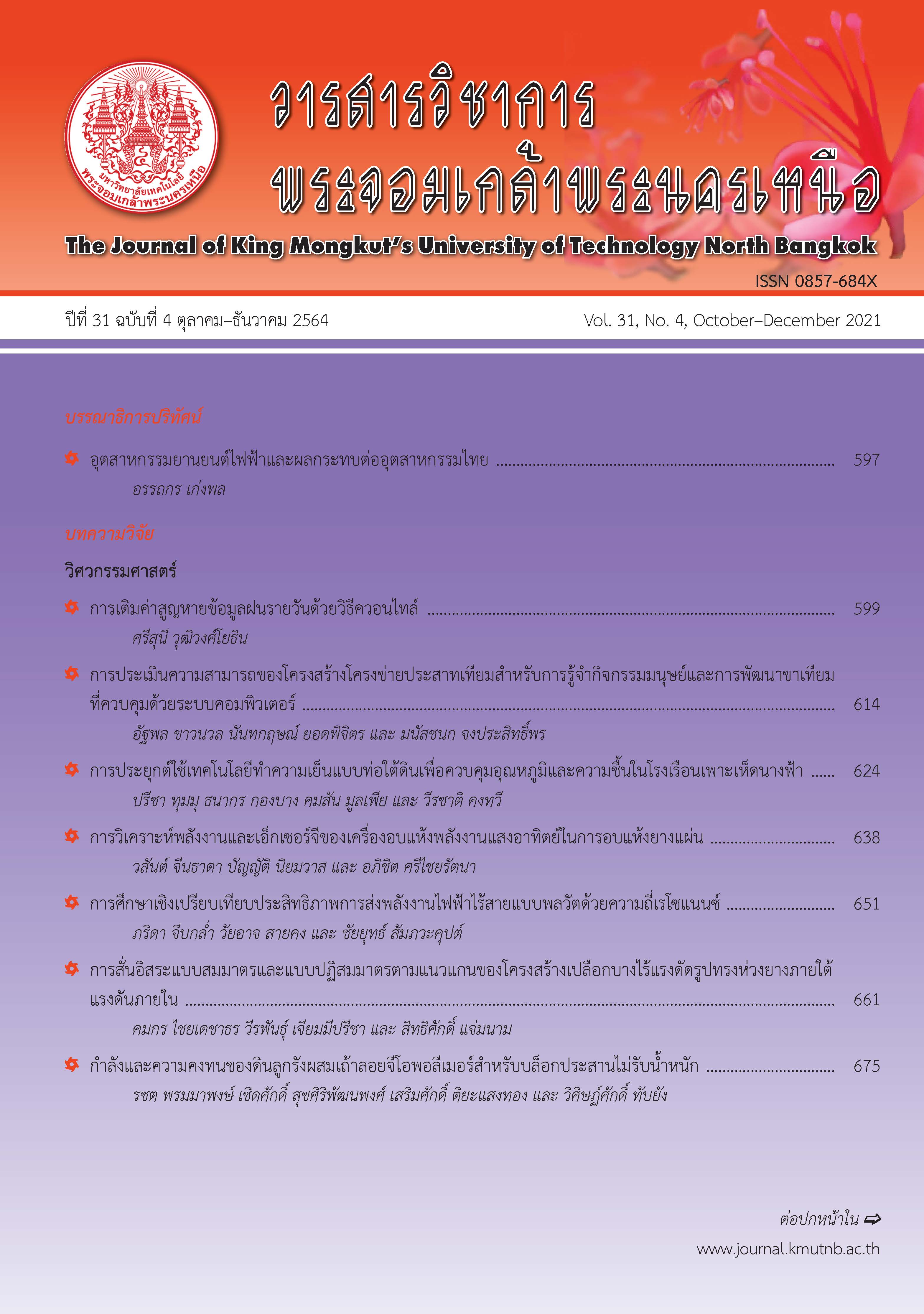การใช้ประโยชน์จากกากถั่วเหลืองเป็นสารเคลือบบริโภคได้เพื่อลดการดูดซับน้ำมันในผลิตภัณฑ์มันฝรั่งทอด
Main Article Content
บทคัดย่อ
งานวิจัยนี้มีวัตถุประสงค์เพื่อใช้ประโยชน์จากกากถั่วเหลืองมาพัฒนาเป็นสารเคลือบบริโภคได้ โดยแบ่งเป็น 2 การทดลอง การทดลองแรกศึกษาการปรับปรุงคุณภาพสารเคลือบกากถั่วเหลืองโดยใช้กรดซิตริก 3 ระดับ ได้แก่ ร้อยละ 0.03, 0.05 และ 0.07 โดยน้ำหนัก และการทดลองที่สองศึกษาผลของความเข้มข้นพลาสติไซเซอร์คือซอร์บิทอล (ร้อยละ 7, 8 และ 9 โดยน้ำหนัก) ในสารเคลือบบริโภคได้จากกากถั่วเหลืองเพื่อลดการดูดซับน้ำมันในมันฝรั่งทอด ผลการทดลองแรกพบว่าการเติมกรดซิตริกที่ความเข้มข้นร้อยละ 0.05 ส่งผลให้สารเคลือบบริโภคได้มีค่าการเกาะติดสูงที่สุด (p<0.05) ผลการทดลองที่สองพบว่าการเติมซอร์บิทอลในสารเคลือบบริโภคได้จากกากถั่วเหลืองมีผลต่อการดูดซับน้ำมันลดลงอย่างมีนัยสำคัญทางสถิติ (p<0.05) โดยมันฝรั่งทอดที่เคลือบสารเคลือบบริโภคได้จากกากถั่วเหลืองร่วมกับการใช้ซอร์บิทอลความเข้มข้นร้อยละ 8 มีปริมาณความชื้นที่สูญเสียไปและปริมาณไขมันทั้งหมดน้อยที่สุด โดยมันฝรั่งทอดมีความกรอบขึ้น และสีที่เหลืองเข้มขึ้นเมื่อเทียบกับตัวอย่างควบคุม จากการทดลองจึงสรุปได้ว่าการใช้สารเคลือบบริโภคได้เพื่อลดน้ำมันถือเป็นอีกทางเลือกหนึ่งเพื่อให้ได้อาหารทอดที่ดีต่อสุขภาพของผู้บริโภคได้
Article Details
บทความที่ลงตีพิมพ์เป็นข้อคิดเห็นของผู้เขียนเท่านั้น
ผู้เขียนจะต้องเป็นผู้รับผิดชอบต่อผลทางกฎหมายใดๆ ที่อาจเกิดขึ้นจากบทความนั้น
เอกสารอ้างอิง
[2] X. Hua, K. Wang, R. Yang, J. Kang, and H.Yang, “Edible coatings from sunflower head pectin to reduce lipid uptake in fried potato chips,” LWT - Food Science and Technology, vol. 62, no. 2, pp. 1220–1225, 2015.
[3] D. D. G. C. Freitas, S. A. G. Berbari, P. Prati, F. M. Fakhouri, F. P. C. Queiroz, and E. Vicente, “Reducing fat uptake in cassava product during deep-fat frying,” Journal of Food Engineering, vol. 94, no. 3, pp. 390–394, 2009.
[4] S. Rimac-Brncic, V. Lelas, D. Rad, and B. Simundic, “Decreasing of oil absorption in potato strips during deep fat frying,” Journal of Food Engineering, vol. 64, no. 2, pp. 237–241, 2003.
[5] M. A. García, C. Ferrero, N. Bertola, M. Martino, and N. Zaritzky, “Edible coatings from cellulose derivatives to reduce oil uptake in fried products,” Innovative Food Science and Emerging Technologies, vol. 3, no. 4, pp. 391–397, 2002.
[6] A. Nezzal, L. Aert, M. Verspaille, G. Henderickx, and A. Redl, “Polymorphism of sorbitol,” Journal of Crystal Growth, vol. 311, no. 15, pp. 3863–3870, 2005.
[7] B. Li, F. Lu, H. Nan, and Y. Liu, “Isolation and structural characterisation of okara polysaccharides,” Molecules, vol. 17, no. 1, pp. 753–761, 2012.
[8] A. D. Garmakhany, N. Aghajani, and M. Kashiri, “Use of hydrocolloids as edible covers to produce low fat french fries,” Latin American Applied Research, vol. 41, no. 3, pp. 211–216, 2011.
[9] Official methods of analysis, 17th ed., AOAC method no. 925.10 (Air Oven Method) for moisture in flour, Gaithersburg, MD, 2000.
[10] J. Rahimi and M. O. Ngadi, “Effect of batter formulation and pre-drying time on oil distribution fractions in fried batter,” Food Science and Technology, vol. 59, no. 2, pp. 820–826, 2014.
[11] W. Ma, S. Rokayya, L. Xu, X. Sui, L. Jiang, and Y. Li, “Physical-chemical properties of edible film made from soybean residue and citric acid,” Journal of Chemistry, vol. 2018, pp. 1–8, 2018.
[12] C. Gamonpilas, W. Pongjaruvat, P. Methacanon, and N. Seetapan, “Effects of cross-linked tapioca starches on batter viscosity and oil absorption in deep-fried breaded chicken strips,” Journal of Food Engineering, vol. 114, no. 2, pp. 262–268, 2013.
[13] O. Vitrac, G. Trystram, and A. Raoult-Wack, “Deep-fat frying of food: Heat and mass transfer, transformations and reactions inside the frying material,” European Journal of Lipid Science and Technology, vol. 102, no. 8–9, pp. 529–538, 2000.
[14] S. Sahin, G. Sumnu, and B. Altunakar, “Effects of batters containing different gum types on the quality of deep-fat fried chicken nuggets,” Journal of the Science of Food and Agriculture, vol. 85, no. 14, pp. 2375–2379, 2005.
[15] R. Sothornvit and J. M. Krochta, “Plasticizer effect on mechanical properties of ß-lactoglobulin films,” Journal of Food Engineering, vol. 50, no. 3, pp. 149–155, 2001.
[16] T. Bourtoom, “Plasticizer effect on the properties of biodegradable blend film from rice starch-chitosan,” Songklanakarin Journal of Science and Technology, vol. 30, no. 1, pp. 149–165, 2008.
[17] M. Mellema, “Mechanism and reduction of fat uptake in deep-fat fried foods,” Trends in Food Science & Technology, vol. 14, no. 9, pp. 364–373, 2003.
[18] M. Kurek, M. Ščetar, and K. Galić, “Edible coatings minimize fat uptake in deep fat fried products: A review,” Food Hydrocolloids, vol. 71, pp. 225–235, 2017.
[19] R. Sothornvit and J. M. Krochta, “ 23 - Plasticizers in edible films and coatings,” in Innovations in Food Packaging. 1st ed. London, UK: Elsevier, pp. 403–433, 2005.
[20] M. J. Quiroz, M. Urriza, A. Pinotti, and N. Bertola, “Plasticized methylcellulose coating for reducing oil uptake in potato chips,” Journal of the Science of Food and Agriculture, vol. 92, no. 7, pp. 1346–1353, 2011.
[21] M. K. Krokida, V. Oreopoulou, and Z. B. Maroulis, “Water loss and oil uptake as a function of frying time,” Journal of Food Engineering, vol. 44, no.1, pp. 39–46, 2000.
[22] R. Y. Ajo, “Application of hydrocolloids as coating films to reduce oil absorption in fried potato chip-based pellets,” Pakistan Journal of Nutrition, vol. 16, no. 10, pp. 805–812, 2017.
[23] A. E. Newton, A. J. Fairbanka, M. Golding, P. Andrewes, and J. A. Gerrard, “The role of the Maillard reaction in the formation of flavour compounds in dairy products-not only a deleterious reaction but also a rich source of flavour compounds,” Food & Function, vol. 3, no. 2, pp. 1223–1326, 2002.

